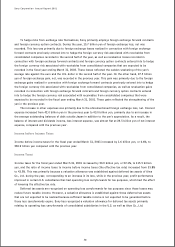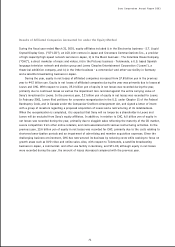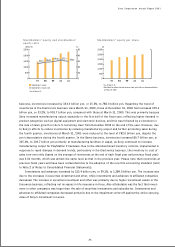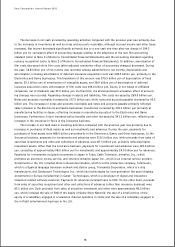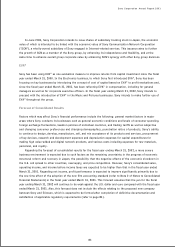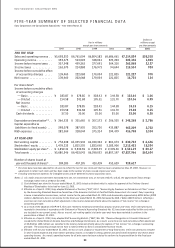Sony 2001 Annual Report Download - page 81
Download and view the complete annual report
Please find page 81 of the 2001 Sony annual report below. You can navigate through the pages in the report by either clicking on the pages listed below, or by using the keyword search tool below to find specific information within the annual report.
Sony Corporation Annual Report 2001
79
In financing activities, the fact that net cash was generated during the year while net cash was used in the
previous year, was primarily due to increases in proceeds from issuance of long-term debt and short-term
borrowings. During the year, proceeds from issuance of long-term debt were 195.1 billion yen. This was primarily
from the issuance of 150.0 billion yen of notes in Japan. On the other hand, payments of long-term debt were
143.3 billion yen. This was primarily from redemption of MTNs and notes in the U.S. Furthermore, the increases
in short-term borrowings were 106.2 billion yen. This was primarily due to issuances of commercial paper in the
U.S., corresponding to funding requirements for working capital. During the year, Sony Corporation paid cash
dividends of 22.8 billion yen.
For reference, unaudited condensed statements of cash flows in the Insurance business are presented
on page 68.
RESEARCH AND DEVELOPMENT
Sony believes research and development activities are vital to the growth of its business. Accordingly, Sony
actively carries out research and development in various areas that are expected to become important in the
future. Such areas include technologies that improve the utility and network connectivity of products, as well as
those technologies that support service businesses carried out over broadband networks. At present, regarding
Sony’s research and development activities, areas that require rapid introduction to market are handled at each
business unit, and lateral areas based on mid-to-long term strategies are handled at corporate laboratories
directly supervised by Sony headquarters. Also, overseas laboratories in the U.S., Europe, and Asia, taking
advantage of resources available in their respective areas, actively collaborate with business units and corporate
laboratories. In April 2001, as part of the reorganization of the group structure, Sony reorganized the corporate
laboratories, overseen directly by Sony headquarters, into the following seven units;
●Internet Laboratories (networking technology)
●Frontier Science Laboratories (material and device technology)
●A3 Research Center (signal processing technology)
●Digital Creatures Laboratory (robotic technology)
●Wireless Telecommunication Laboratory (wireless telecommunication technology)
●Cyber Technology Laboratory (frameworks for data processing technology)
●Fusion Domain Laboratory (fusion of device and nanometer technologies)
Research and development expenses for the fiscal year ended March 31, 2001 increased by 22.2 billion
yen, or 5.6%, to 416.7 billion yen compared with the previous year, primarily in the Electronics business. However,
the ratio of research and development expenses to sales (excluding the Insurance business) decreased from
6.3% to 6.0%. With respect to the breakdown of major research and development expenses, such expenses in
the Electronics business increased by 22.8 billion yen, or 6.4%, to 380.9 billion yen, and such expenses in the
Game business decreased by 0.7 billion yen, or 1.9%, to 34.2 billion yen. Of such expenses in the Electronics
business, slightly more than 70% was for development of prototypes of new products and the remainder,
slightly less than 30%, was for the development of mid-to-long term new technologies in such areas as
semiconductors, communications, and displays.



